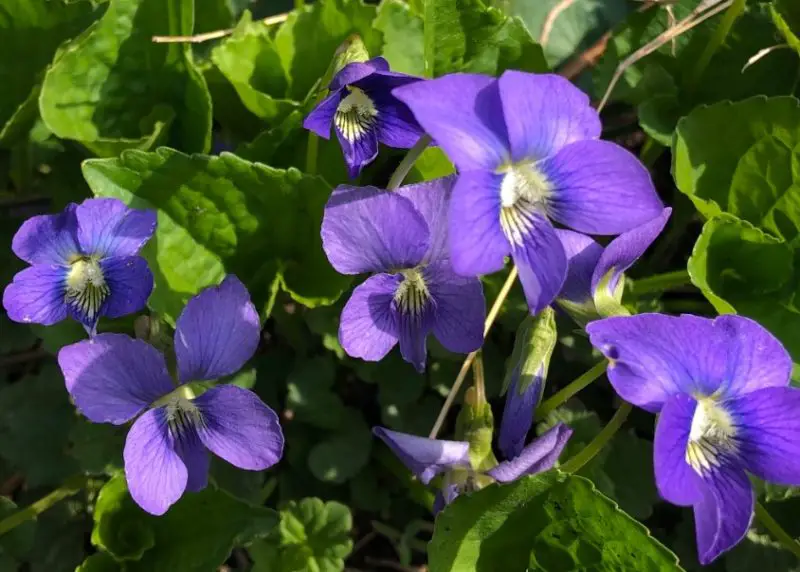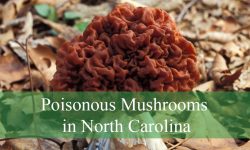Wood Violet, also known as Viola papilionacea, is a charming wildflower commonly found in North America. With its distinctive purple petals and butterfly-like shape, this flower not only adds a vibrant touch to your garden but also brings a natural and serene atmosphere.
Here’s a comprehensive guide on how to care for and grow Wood Violet effectively.
Characteristics of Wood Violet (Viola papilionacea)

Appearance and Color
Wood Violet (Viola papilionacea) is celebrated for its charming and delicate flowers, which display a striking range of colors. The blooms are typically deep purple, lending a rich, royal hue to garden landscapes. However, variations in color are not uncommon, with some flowers showcasing light lavender tones that bring a soft, pastel touch. In rarer instances, Wood Violet produces pure white blossoms, which offer a stark and elegant contrast against its lush foliage.
The flowers consist of five petals arranged in a unique butterfly-like formation, a characteristic that gives the species its name “papilionacea,” derived from the Latin word for butterfly. The lower petal, known as the “lip,” is slightly larger and often marked with delicate, darker purple veins that act as nectar guides for pollinators. The two lateral petals sometimes bear tiny tufts of hair, adding subtle texture to the flower’s appearance.
Accompanying the vibrant blooms are the plant’s heart-shaped leaves, which are a rich, glossy green. These leaves grow in a basal rosette pattern, meaning they emerge from the base of the plant and spread outward, creating a dense, leafy ground cover. The scalloped edges and smooth surface of the leaves enhance their visual appeal, while their lush green color beautifully offsets the vividness of the flowers.
Growing Environment
Wood Violet naturally thrives in woodland habitats, where it enjoys the dappled sunlight filtering through tree canopies. It prefers partial shade, as direct sunlight can cause the delicate petals to fade or wilt. Ideal growing conditions include consistently moist, well-drained soils rich in organic matter, mimicking the humus-rich forest floors from which it originates. The plant is particularly well-suited to temperate climates, showing remarkable resilience to cold weather and even surviving light frosts.
This species is highly adaptable and can flourish in a variety of soil types, although it prefers slightly acidic to neutral pH levels. It spreads easily by rhizomes, forming lush mats of greenery and vibrant flowers. Gardeners appreciate this characteristic for its usefulness as a ground cover in shaded garden corners, under deciduous trees, or along shaded pathways.
In addition to its ornamental value, Wood Violet plays an important ecological role. It provides nectar for early-season pollinators, including bees and butterflies, and serves as a host plant for the larvae of certain fritillary butterflies. Its ability to naturalize and spread effortlessly makes it a low-maintenance yet impactful addition to native plant gardens and woodland landscapes.
How to Grow Wood Violet (Viola papilionacea)
Choosing the Right Location and Soil
Light Requirements:
Wood Violet thrives best in partial shade, making it an excellent choice for planting under trees or along shaded garden borders. It enjoys gentle morning sunlight but should be protected from harsh afternoon sun, which can scorch its delicate petals and leaves. Although it can tolerate full shade, blooming may be less abundant in very low light conditions.
Soil Preferences:
For optimal growth, Wood Violet prefers loose, well-draining soil enriched with organic matter, such as compost or leaf mold. The ideal soil should be rich in nutrients to support the plant’s lush foliage and vibrant blooms. A slightly acidic to neutral pH range of 6.0 to 7.0 is most suitable. Avoid heavy clay soils that retain water, as they can cause root rot. If planting in containers, use a high-quality potting mix designed for flowering plants.
Planting and Propagation
Planting Time:
The best time to plant Wood Violet is in early spring or fall when temperatures are moderate. Planting in spring allows the roots to establish before the heat of summer, while fall planting gives the plants a head start for the following growing season.
Propagation Methods:
-
By Seeds:
- When to Sow: Directly sow seeds outdoors in the fall. Wood Violet seeds require a cold stratification period, meaning they need exposure to cold temperatures before they will germinate. Planting them in fall naturally exposes the seeds to winter conditions, ensuring successful germination in spring.
- How to Sow: Lightly press the seeds into the soil without fully covering them, as they need light to germinate. Keep the soil moist but not waterlogged during the germination period.
-
By Division:
- When to Divide: Mature clumps of Wood Violet can be divided either in early spring before new growth starts or in late fall after blooming has finished.
- How to Divide: Carefully dig up the plant clump and gently separate the roots into smaller sections, ensuring each division has at least a few healthy leaves and roots. Replant the divisions at the same depth as the original plant, spacing them about 6 to 12 inches apart to allow room for spreading. Water thoroughly after planting to help the new divisions establish.
Watering and Fertilization
Watering Requirements:
Wood Violet prefers consistently moist soil but is sensitive to waterlogged conditions. Deeply water the plant once a week, ensuring the moisture reaches the root zone. In hotter weather or during dry spells, increase watering frequency. To maintain consistent moisture, consider adding a layer of organic mulch around the base of the plants, which helps retain soil moisture and regulate soil temperature.
Fertilization Needs:
Wood Violet is a low-maintenance plant and does not require heavy fertilization. In early spring, apply a light layer of compost or a balanced, slow-release fertilizer to provide essential nutrients for healthy growth and blooming. Avoid over-fertilizing, as excessive nutrients can lead to lush foliage at the expense of flowers. A single application per year is typically sufficient.
Caring for Wood Violet
Pruning and Maintenance
Deadheading and Flower Care:
To encourage continuous blooming, it is beneficial to remove spent flowers regularly. This process, known as deadheading, not only enhances the plant’s appearance but also prevents excessive self-seeding. Wood Violet has a tendency to self-seed prolifically, which can lead to rapid spreading and potentially invasive growth. By promptly removing faded blooms, you can better control its spread and maintain a more organized garden bed.
Foliage Maintenance:
Wood Violet’s heart-shaped leaves can become overgrown or damaged due to weather conditions or pests. To maintain a tidy appearance, periodically trim back any leggy, damaged, or yellowing foliage. Use clean, sharp scissors or pruning shears to avoid tearing the leaves. This practice not only keeps the plant looking neat but also promotes healthy new growth. In early spring, before new shoots emerge, consider a light pruning to remove any winter-damaged leaves.
General Maintenance Tips:
- Monitor for overcrowding, as dense growth can inhibit air circulation and increase the risk of fungal diseases. If necessary, thin out the plants to improve airflow.
- Apply a light layer of organic mulch around the base of the plants to suppress weeds, retain soil moisture, and maintain a stable soil temperature.
Pest and Disease Control
Pest Resistance and Occasional Issues:
Wood Violet is generally pest-resistant, making it a relatively low-maintenance choice for gardens. However, it can occasionally attract a few common garden pests:
- Aphids: These small, sap-sucking insects may cluster on the stems or undersides of leaves. If left unchecked, they can cause leaf curling and stunted growth. To control aphids, spray the affected areas with natural insecticidal soap or neem oil. Alternatively, a strong jet of water from a hose can dislodge minor infestations.
- Slugs and Snails: These pests are attracted to the moist, shaded environment preferred by Wood Violet. They chew irregular holes in the leaves, affecting the plant’s appearance. To manage slugs and snails, sprinkle diatomaceous earth around the base of the plants as a natural deterrent. Additionally, removing garden debris and keeping the area clean reduces hiding spots for these pests.
Disease Prevention and Control:
While Wood Violet is generally resistant to diseases, it can be susceptible to fungal issues under conditions of poor air circulation and excessive moisture. Common fungal diseases include:
- Powdery Mildew: Characterized by a white, powdery coating on the leaves, this fungal infection can be minimized by ensuring good air circulation and avoiding overhead watering. If necessary, treat affected plants with a mild fungicide.
- Leaf Spot: This causes dark, irregular spots on the foliage. Remove and dispose of infected leaves promptly to prevent the spread of the fungus.
Preventative Measures:
- Space the plants appropriately (6 to 12 inches apart) to allow for proper airflow.
- Water at the base of the plant rather than overhead to keep the foliage dry and reduce the risk of fungal infections.
Winter Care
Cold Hardiness and Preparation:
Wood Violet is a hardy perennial that can survive cold winters without much protection. It is well-suited to USDA hardiness zones 4 through 9, tolerating temperatures as low as -30°F (-34°C). The plant naturally enters dormancy during winter, with its foliage dying back to the ground.
Mulching for Insulation:
Although Wood Violet is cold-tolerant, adding a 2- to 3-inch layer of organic mulch (such as shredded leaves, pine needles, or bark chips) around the base of the plants provides several benefits:
- Insulation: The mulch layer helps insulate the roots against fluctuating winter temperatures, preventing freeze-thaw cycles that can heave the roots out of the soil.
- Moisture Retention: It conserves soil moisture during dry winter months, reducing the risk of root desiccation.
Winter Maintenance Tips:
- Avoid cutting back the foliage completely until late fall, as it provides natural protection to the crown of the plant.
- In early spring, remove the mulch gradually to allow new growth to emerge without obstruction.
- Check for signs of frost heaving (when the freeze-thaw cycle pushes the plant roots out of the ground) and gently press any exposed roots back into the soil.
Benefits of Growing Wood Violet
Attracts Pollinators
One of the most significant ecological benefits of growing Wood Violet is its ability to attract a variety of pollinators, thereby promoting biodiversity in your garden. The vibrant purple and lavender blooms are especially appealing to bees and butterflies.
- Bees: Wood Violet’s delicate petals and subtle fragrance draw in native bees, which play a crucial role in pollinating other garden plants. Its nectar-rich flowers provide an essential food source during early spring when few other flowers are in bloom.
- Butterflies: The bright colors and butterfly-like shape of the flowers are particularly attractive to various butterfly species. Wood Violet also serves as a host plant for the larvae of certain fritillary butterflies, including the Great Spangled Fritillary (Speyeria cybele). The caterpillars feed on the violet leaves, contributing to the life cycle of these beautiful pollinators.
- Ecosystem Support: By supporting pollinators, Wood Violet indirectly promotes the health and productivity of surrounding plants, enhancing overall garden biodiversity and ecosystem stability.
Ground Cover
Wood Violet’s dense foliage and spreading habit make it an excellent choice for use as ground cover. Its heart-shaped leaves grow in a lush basal rosette pattern, forming a thick, green carpet that covers bare soil effectively.
- Soil Erosion Prevention: The extensive root system of Wood Violet helps stabilize the soil, reducing erosion on slopes or in garden areas prone to runoff. This characteristic is particularly valuable for preventing soil degradation and maintaining landscape integrity.
- Weed Suppression: The dense leaf cover naturally shades the ground, inhibiting the growth of weeds by blocking sunlight. This reduces the need for chemical herbicides and minimizes garden maintenance.
- Aesthetic Appeal: Beyond its practical functions, Wood Violet’s vibrant foliage and charming flowers create a visually appealing ground cover, adding texture and color to shaded garden areas, under trees, or along pathways.
Edible and Medicinal Uses
Wood Violet is not only beautiful but also surprisingly useful in culinary and medicinal applications. Both the flowers and leaves are edible, providing a nutritious and flavorful addition to various dishes.
Culinary Uses:
- Flowers: The delicate flowers are often used as colorful garnishes on salads, desserts, or drinks. They add a mild, sweet flavor and a touch of elegance to culinary presentations. Crystalizing the flowers with sugar is a popular method for decorating cakes and pastries.
- Leaves: The tender young leaves can be eaten raw in salads or cooked as a leafy green in soups and stews. They have a mild, slightly peppery taste similar to spinach.
- Teas and Syrups: Both flowers and leaves can be steeped to make herbal teas or infused to create violet syrups, which are used as natural flavorings and colorings in beverages and desserts.
Nutritional Value:
- Wood Violet is rich in vitamins A and C, making it a nutritious addition to the diet. Vitamin A supports vision and immune function, while vitamin C boosts immunity and promotes healthy skin.
- The plant also contains antioxidants, which help protect the body from free radical damage.
Medicinal Benefits:
- Anti-inflammatory Properties: Traditionally, Wood Violet has been used in herbal medicine for its anti-inflammatory and soothing properties. It is known to alleviate minor skin irritations, insect bites, and rashes when applied as a poultice or infused in oils.
- Respiratory Support: Violet tea has been used as a natural remedy for respiratory issues, including coughs and congestion, due to its mild expectorant properties.
- Digestive Aid: The plant’s mild laxative effect can help with digestion and relieve constipation when consumed in moderate amounts.
Caution:
While Wood Violet is generally safe for consumption, it is essential to avoid confusion with other, potentially toxic violet species. Always ensure accurate identification before using the plant for culinary or medicinal purposes. Additionally, consume it in moderation, as excessive intake may cause digestive discomfort.
Conclusion
Wood Violet (Viola papilionacea) is a low-maintenance, versatile wildflower that adds natural beauty and charm to any garden. By choosing the right location, maintaining consistent moisture, and providing occasional fertilization, you can enjoy the vibrant blooms and lush foliage of this delightful plant year after year. Start growing Wood Violet today and bring a touch of wild elegance to your outdoor space.






